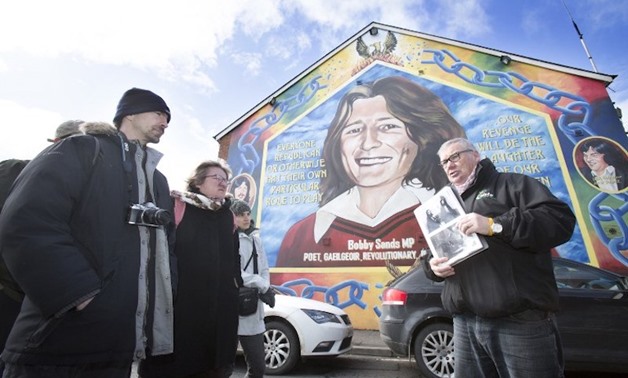
Coiste guide Peadar Whelan (right) talks to his group of tourists in front of a mural to of IRA hunger striker Bobby Sands during a political guided tour in west Belfast March 27, 2018. — AFP pic
BELFAST - 9 April 2018: Bullet-scarred walls and murals to honour the dead serve as a reminder of Northern Ireland’s bloody conflict, a story now recounted to tourists by former fighters 20 years after their guns fell silent.
Republican Peadar Whelan is one such guide, having spent 16 years behind bars for trying to kill a British policeman in the late 1970s.
The 60-year-old now earns a living recalling “The Troubles”.
The conflict broke out in 1969 and only ended with the Good Friday Agreement signed 20 years ago on Tuesday but the wounds are far from healed and there are fears now that looming Brexit could upset the peace.
“It was a war here,” said Whelan as he began his tour outside a former school on Falls Road, a majority Catholic street separated from the Protestant community by a “peace wall” — one of dozens of separation barriers in the province.
The brick walls of the now-abandoned building still bear the bullet holes of the Loyalist snipers.
Falls Road was the scene of numerous clashes between Catholic Republicans and Protestant Loyalists and the British army had a surveillance post at the top of the nearby Divis Tower.
“Through the tour we’ll hopefully give you a real sense of the way in which the whole kind of military, colonial, occupying objective of the British army... becomes clear,” Whelan said.
Arriving at a memorial garden for Republican activists and Irish Republican Army (IRA) fighters, Whelan recalled the “volunteers” who fell during the violence, but whom the other side describes as terrorists.
The group of around 10 tourists is then taken to the west of Falls Road, to a large fresco depicting a smiling Bobby Sands, the militant nationalist who died in his cell in 1981 after a 66-day hunger strike.
‘No regrets’
Whelan described the solidarity among Republican prisoners at the time.
“I was 19 years of age, hadn’t a clue,” he explained.
“After three days of torture and abuse ,my door opened and this man (Sands) has given me a bag with biscuits and books and newspapers and some fruit,” he added.
“Somebody just saying ‘you’re not on your own here’.”
The next stop takes in the peace wall that has separated the Catholics of Falls Road from the Protestants of Shankill Road since 1969.
On the other side of the wall, Noel Large continues the tour.
He is the same age and has spent the same time in prison as Whelan, but is from the loyalist camp.
The tattooed former militant, who joined a banned group aged 17, said he “grew up to fear and be suspicious of Catholics”.
As a young man he was involved in murders, attempted murders and robberies.
Large was sentenced to four life sentences, totalling 357 years, following his arrest in 1982.
But he was finally released in 1998 as part of the Good Friday agreement that brought an official end to the violence.
“What I did didn’t change anything, it made things worse,” said Large, now a grandfather.
By contrast, Whelan claimed to have “no regrets”.
“I am who I am, I was who I was,” he added.
The diametrically opposed paths of the two men converged little-by-little as the violence subsided.
Today, they both practise their storytelling skills, taking visitors to neighbourhoods they know by heart.
But Whelan does not see the “peace walls” disappearing any time soon, believing that even though “the war is over”, people remain worried about the return of violence.
“At some point, the walls will go but when... who knows?” he said.
Large agreed, saying: “It’s going to take a couple of generations for people to move beyond and stop thinking of the Troubles”.
One major concern is Brexit, with the future of the border between Northern Ireland and Ireland a key sticking point that some fear could reignite tensions.
“Brexit is the elephant in the room,” said Large. “We don’t know what the implications are.
“No-one wants the return of a hard border,” he added. — AFP


Comments
Leave a Comment